You can listen to Hoosier History Live! live on the air each Saturday, or listen online at the WICR website during the broadcast. We invite you to visit our website!
Feb. 26 show
Police history in Indy
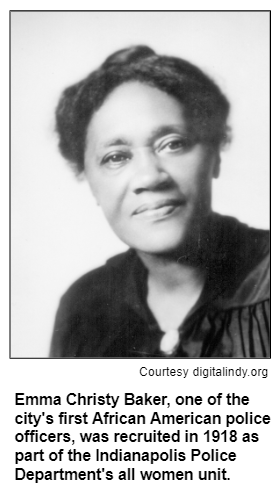 With the recent tragic on-duty death of Indianapolis Metropolitan Police Department Officer David Moore, community-wide grief over his passing, and various controversies surrounding other members of the force, the spotlight has been on the police recently. Hoosier History Live! is seizing the moment to explore the history of an organized police force in the Hoosier capital and how it has unfolded for more than 150 years.
With the recent tragic on-duty death of Indianapolis Metropolitan Police Department Officer David Moore, community-wide grief over his passing, and various controversies surrounding other members of the force, the spotlight has been on the police recently. Hoosier History Live! is seizing the moment to explore the history of an organized police force in the Hoosier capital and how it has unfolded for more than 150 years.
Nelson's studio guests will be Capt. Craig Fishburn, a 28-year veteran of the police force, and Sabrina Young, vice president of the Indianapolis Police Historical and Educational Foundation. Captain Fishburn, who is currently assigned to IMPD's east district, helped put together Indianapolis Police Department: A Proud Tradition of Service (Turner Publishing Co., 2000).
In connection with Black History Month, Capt. Fishburn and Ms. Young, who is a community volunteer for the force, will share insights about early African-American police officers - and women officers as well.
According to several accounts, the first African-American police detective in Indianapolis, Benjamin Thornton, was appointed to the force in 1875 and promoted to detective 10 years later. He was an escaped slave who had settled in Indianapolis.
Trail-blazers also included a well-known business and civic leader, Emma Christy Baker, who ran a laundry. In 1918, she became the first black female officer on what was then IPD. She patrolled a downtown beat. Despite her achievements, Officer Baker was buried in an unmarked grave at Crown Hill Cemetery, in part because she had no immediate survivors. Capt. Fishburn, our guest, attended the dedication in 2003 of a memorial headstone on Officer Baker's burial site after a fund-raising campaign led by a current IMPD officer, Marilyn Gurnell.
After some breakthroughs during the 1920s, when IPD employed the country's largest all-female unit, the department did not hire women for street patrol again until 1968. Nelson and his guests will explore how this unfolded.
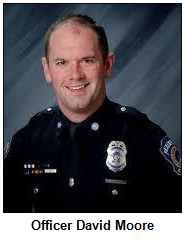 They also will time-travel much farther back, exploring perceptions during the 1840s and '50s that - because of the waves of immigrants, the arrival of railroads and battles over the propriety of alcohol consumption - the city "was in the grip of a crime wave," according to The Encyclopedia of Indianapolis.
They also will time-travel much farther back, exploring perceptions during the 1840s and '50s that - because of the waves of immigrants, the arrival of railroads and battles over the propriety of alcohol consumption - the city "was in the grip of a crime wave," according to The Encyclopedia of Indianapolis.
These fears apparently resulted in a clamor for a paid city police force. It was launched in fits and starts during the 1850s and early '60s. (Before 1854, the peace in Indianapolis was maintained by a town marshal, a sheriff, a few deputies and various night watchmen. The night watchmen were volunteers.) Initially, officers were identified by only a silver star. They got blue uniforms in 1862. The first officers walked their beats. Bicycle units began in 1897. Horse patrols kicked off around the turn of the century.
"When needed," according to an IMPD history on the city of Indianapolis' website, "the department's first officers commandeered private (horse-drawn) wagons and conveyed drunks to the station in a wheelbarrow." The first police automobile in Indy was purchased in 1904.
Historic uniforms, badges and weapons, including nun chucks once used to subdue perpetrators, will be exhibited at a police history museum underway in a historic building at South Pennsylvania and Georgia streets near Conseco Fieldhouse. (Capt. Fishburn emphasizes that nun chucks have not been used by Indianapolis police for many decades.)
Sabrina Young is an organizer of the interactive museum, which will be known as Cop City and is being privately funded. She will share details about Cop City, which is slated to open in time for Super Bowl visitors next February.
Much of the focus at Cop City will be on the education of children about public safety. In addition to exhibits about IPD's history, Ms. Young says Cop City will spotlight the local heritage of other law enforcement officials such as sheriff's deputies and FBI agents.
Roadtripper: Maple Syrup Fest in Jackson County
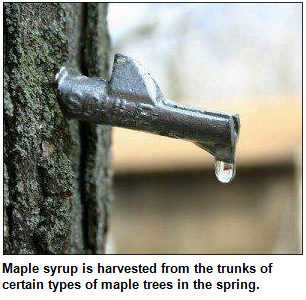 Roadtripper Chris Gahl of the ICVA suggests that we head down to Medora in Jackson County the first two weekends of March for the National Maple Syrup Festival. Just as maple-sugaring season gets under way, maple syrup producers from all over the country will be able to showcase their best recipes at this year's Sweet Victory Challenge. Historic re-enactors will show festival goers how Native Americans and, later, white settlers in southern Indiana learned to tap maple trees and produce the sweet stuff.
Roadtripper Chris Gahl of the ICVA suggests that we head down to Medora in Jackson County the first two weekends of March for the National Maple Syrup Festival. Just as maple-sugaring season gets under way, maple syrup producers from all over the country will be able to showcase their best recipes at this year's Sweet Victory Challenge. Historic re-enactors will show festival goers how Native Americans and, later, white settlers in southern Indiana learned to tap maple trees and produce the sweet stuff.
The festival includes a children's area and live bluegrass music, so plan to head down to John Mellencamp's native Jackson County for a taste of early spring out in the country!
History Mystery question
The largest residential robbery in American history occurred in 1977 at an Indianapolis home. More than $7 million had been hidden in the house by its owner, who had developed an intense distrust of banks. She had hidden money in sewing kits, headboards of beds and vacuum cleaner bags. A group of suspects was implicated in the robbery of the Northside home, during which its owner was killed. Some of the perpetrators later returned to steal more money and set the house on fire.
Various law enforcement agencies quickly made a series of arrests in the crime, which drew worldwide attention.
Question: Who was the victim in the 1977 crime?
To win the prize, you must call in with the correct answer during the live show. The call-in number is (317) 788-3314, and the prize is a two tickets to "If These Walls Could Tell" at the new Indiana Landmarks Center at 1201 N. Central Avenue in Indianapolis on Friday, April 29. The prize is courtesy of Indiana Landmarks.
History revelers celebrate show's third anniversary at Morris Butler House
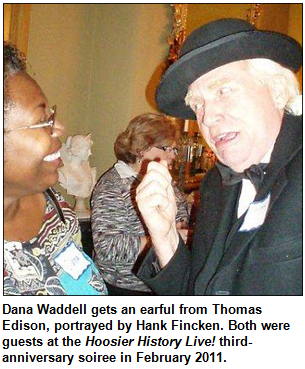 The 1865 Morris Butler House came alive once again on the evening of Thursday, Feb. 17th as about 80 history fans celebrated the third anniversary of Hoosier History Live! The soirée was once again hosted by our friends at Indiana Landmarks. Special thanks to Marsh Davis and Suzanne Stanis for the arrangements.
The 1865 Morris Butler House came alive once again on the evening of Thursday, Feb. 17th as about 80 history fans celebrated the third anniversary of Hoosier History Live! The soirée was once again hosted by our friends at Indiana Landmarks. Special thanks to Marsh Davis and Suzanne Stanis for the arrangements.
Thomas Edison was portrayed by Hank Fincken, and pioneer songs were performed by Janet Gilray and Leslie Gamero. Thanks to Lorraine Phillips Vavul and Sally Cook for bringing the birthday cakes. Thanks also to volunteers Michael Trudeau and Bill Holmes.
Your team on the Hoosier History Live! e-project,
Nelson Price, host and creative director
Molly Head, producer, (317) 927-9101
Chris Gahl, Roadtripper
Richard Sullivan, webmaster and tech director
Pam Fraizer, graphic designer
Garry Chilluffo, creative consultant
www.hoosierhistorylive.org





Please tell our sponsors that you appreciate their support: Avant Garb, Coby Palmer Designs, Indiana Historical Society, Lucas Oil and Story Inn.
 Acknowledgments to Print Resources, Indianapolis Marion County Public Library, Monomedia, Indiana Humanities Council, Indianapolis Convention & Visitors Association, WICR-FM, Fraizer Designs, Chelsea Niccum and many other individuals and organizations. We are an independently produced program and are self-supporting through organizational sponsorships, grants and through individual tax-deductible contributions through the Indiana Humanities Council. Visit our website to learn how you can support us financially.
Acknowledgments to Print Resources, Indianapolis Marion County Public Library, Monomedia, Indiana Humanities Council, Indianapolis Convention & Visitors Association, WICR-FM, Fraizer Designs, Chelsea Niccum and many other individuals and organizations. We are an independently produced program and are self-supporting through organizational sponsorships, grants and through individual tax-deductible contributions through the Indiana Humanities Council. Visit our website to learn how you can support us financially.
March 5 show
Donald Davidson on the Speedway's 100 years
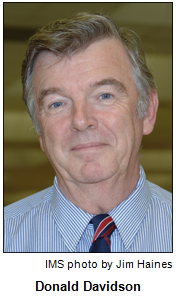 Because we're in what's being called the "centennial era" of the Indianapolis Motor Speedway - a celebration that began in 2009 to mark the 100th year of the opening of the world-famous racetrack and will continue through May with the 100th anniversary of the inaugural Indianapolis 500 in 1911 - it's not jumping the gun, or green flag, to roar into track history.
Because we're in what's being called the "centennial era" of the Indianapolis Motor Speedway - a celebration that began in 2009 to mark the 100th year of the opening of the world-famous racetrack and will continue through May with the 100th anniversary of the inaugural Indianapolis 500 in 1911 - it's not jumping the gun, or green flag, to roar into track history.
Our guest should draw cheers from Hoosier History Live! listeners who have been clamoring for him to visit us during the centennial era. Speedway historian extraordinaire Donald Davidson, who enjoys international fame for his encyclopedic knowledge of all aspects of the Indy 500, will join Nelson in studio.
A native of England who became obsessed with the Speedway as a boy overseas, Donald showed up at the track in 1964 and instantly wowed Hoosiers with the depth of his 500-Mile Race trivia. 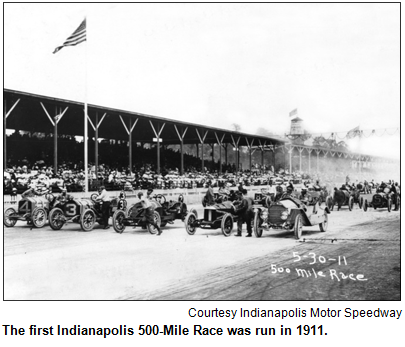 Having Donald Davidson in our studio will be the ideal opportunity for listeners to call in and ask their most burning questions about racing folklore and fact.
Having Donald Davidson in our studio will be the ideal opportunity for listeners to call in and ask their most burning questions about racing folklore and fact.
Expect Donald and Nelson to share insights about their mutual friend, Tom Carnegie, the legendary "Voice of the Speedway," who died Feb. 11. Donald also will separate fact from myth about the controversial inaugural race in 1911 won by Ray Harroun in an Indianapolis-made Marmon Wasp. Even casual fans of the 500 won't want to miss this show.
© 2011 Hoosier History Live! All rights reserved.